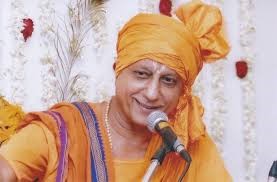 |
THREE TYPES OF SAMADHIS
By Kinkar Vitthal Ramanuja
(Excerpts from Shri Vithhal Uvaach)

“There are three types of samadhis. One savikalpa and two nirvikalpa. In savikalpa samadhi you do a vikalpa, that is, you know who you are meditating on, the deity on whom you are doing dhyana. So even when you attain merger, the awareness of the object of meditation remains. In this samadhi, you can get out of the trance easily, at will. In the other two types, the nirvikalpa ones, the identity of the meditator is lost. There is no vikalpa. Someone else has to bring the soul to mortal consciousness. Of these, in the first one, which lasts for few hours or more, one has to whisper some mantra in the ears of the person in samadhi, or sing naam samkirtan, to bring him down. In Thakur’s case the mantra to bring him down was “Sri Ram Ram Ram”. By singing “Sri Ram Ram Ram” one could bring him to the mortal plane.” While narrating this, Vitthal Maharaj, in His divine voice, sang the Sri Ram Ram Ram bhajan for a few moments and then continued. “In the third type of samadhi there is no body consciousness at all. Hence the person can stay in that state for 21 days or so - after that the body drops on its own. Rarely can the soul return to the body in this type of samadhi. Thakur’s samadhi belonged to the second and third category.”
"Thakur went into profound meditation in the year 1957. This was his famous mauna, which lasted for twenty-two months at a stretch. He was busy writing books in the leisure hours with an uninterrupted speed. He took to kshetra sannyasa i.e., renounced all contact with people and confined himself to the cave."
“Gurudeva (Sitaram Omkarnath) commanded me to be fully in the spiritual life. After my post-graduation, when I earned a good job in Bank of India, He said: “यह मेरा पोता है, यह नौकरी नही करेंगा, ध् ं यान करेंगा” (This is my grandson, he will not take up a regular job, he will spend his years in meditation.!)”
Q. Every now and then you refer to Sri Sri Thakur with the epithet samanavaya unmukh, what do you allude to in this?
A. Thakur was the reconciler of varied conceptions of the highest state of yoga such as jivanmukta, sthitaprajna, bhagavad bhakta, gunaatita, ati varnaashrami of the suta samhita, the Brahman of the Mahabharata, paramhamsa described in shrutis and so on. All these, Thakur says, are synonyms. By samanvaya unmukh, what is meant is that He was intent on reconciling differences in the paths.
Q. Between the two, penning the biography of the acharya of the sampradaya and the grand biography of Sitaramdas Omkarnath, which one gladdens you more?
A. Undoubtedly, composing the grand biography of Thakur Sri Sri Sitaramdas Omkarnath gladdens me more.
|
 |